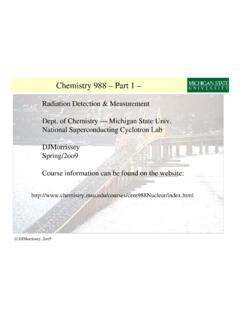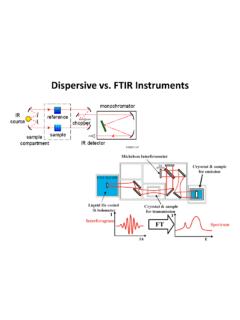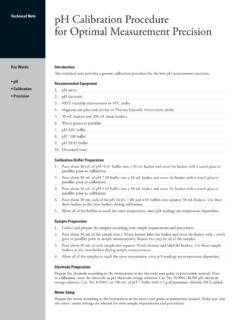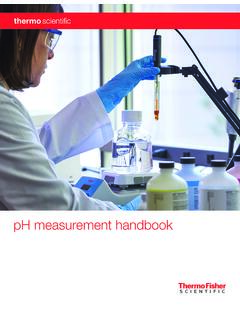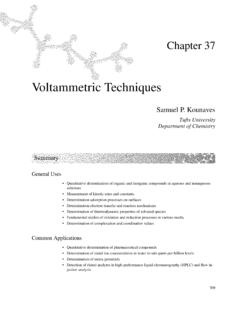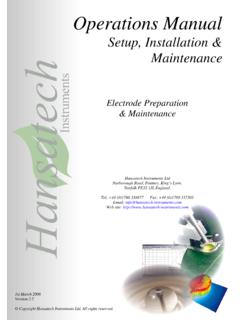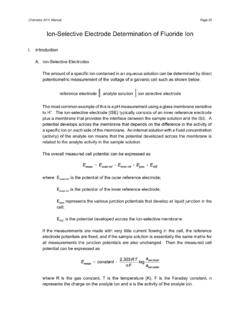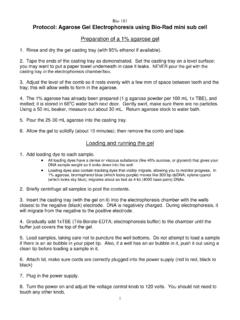Transcription of EXPERIMENT 5. CYCLIC VOLTAMMETRY - Michigan State …
1 -1- EXPERIMENT 5. CYCLIC VOLTAMMETRYO bjectives1. To determine the capacitance of electrochemical To determine the formal potential and diffusion coefficient of Fe(CN) To use CYCLIC VOLTAMMETRY to understand the electrochemistry of Co(NH3)63+.4. To investigate the effects of electrode contamination on CYCLIC Reactions and electrode CapacitanceFigure 1 describes the process that occurs in simpleelectrode reactions. In the case of reduction, a species (O)capable of receiving an electron from the electrode diffusesto the surface, receives an electron and diffuses away fromthe surface.
2 Current at the surface is generated by thetransfer of electrons from the electrode to the redoxspecies. In solution current is carried by migration of already studied this in your measurements can ask whether a current can occur if there isno species in the solution that can transfer electrons to thesurface at the potential of interest. The answer is that atransient current can flow because the electrode -solutioninterface will behave as a capacitor. As the potential of theelectrode is varied, ions move to the surface to form a double-layeras show in Figure strictly speaking an electrode -solution interfacein the absence of a redox couple is not a pure parallel-platecapacitor, it behaves rather like one and a parallel-plate capacitormodel is often adequate to describe electrochemical systems.
3 Useof this model allows us to learn about the behavior of electrodes inthe absence of a redox a simple parallel plate capacitor, charge on thecapacitor, Q, is proportional to the voltage drop across thecapacitor, E:electrodene-ORBulkdiffusionO*R*doublel ayerCdlRctZDRsolnFigure 1. Electrochemical systemthat includes electron transferalong with its equivalent ++++++---+++Figure 2. Schematic diagramof an electrical double (1)-2-The proportionality constant C is the capacitance of the medium. The simplest description ofelectrochemical capacitance is the Helmholtz model given by:where is the dielectric constant of the material separating the parallel plates, o is thepermittivity of free space, l is the separation between the plates, and A is the area of theelectrode.
4 This model does not adequately describe all electrochemical interfaces as thecapacitance can depend on both potential and the supporting electrolyte. Still it is a helpfulconstruct. Capacitance is a crucial factor in electrochemical experiments because it gives rise tocurrent during the charging of the capacitor. Rather logically (and without imagination), weterm this charging current. To calculate the magnitude of this current, we differentiate equation(1) with respect to t and assume that capacitance is constant:Recognizing that dQ/dt is an expression for current and dE/dt is the potential scan rate , weobtain:From this very simple derivation, we have an expression for the charging current at steady statewhen applying a ramping voltage.
5 Thus by measuring the charging current at a given scan rate,you can determine the capacitance of the system. If there is no possibility for electron transferbetween the solution and the electrode (we don t add a redox couple) this is the only current thatwe will s now consider the very simple CYCLIC VOLTAMMETRY (no active redox couple present) EXPERIMENT shown in Figure 3. We apply the potential form shown in the figure. Initially, wehave a sharp rise in current because of a sharp change in the scan rate . The current then reachessteady State as we are constantly varying the voltage.
6 At reversal of the scan rate, the currentt(-) E0iE (-Figure 3. Schematic explanation of a CYCLIC VOLTAMMETRY EXPERIMENT in the absence of aredox =(2)dtdECdtdQ=(3)Cvi=(4)-3-changes sign, and when we stop scanning, current goes to the first part of this laboratory, you will run a CV without a redox couple anddetermine the capacitance of the electrode . Typically values of C/A are about 20 F/cm2. Fromthe value of the capacitance, you can estimate the value of the dielectric constant. You canassume a separation of about 3 between the electrode and electrostatically bound ions.)
7 Areasonable value for dielectric constants of organic compounds is 2-3. The dielectric constant ofwater is about 80. Double layer dielectric constants are generally not the same as that of waterbecause the first few layers of water on a surface donot behave as bulk will also try to vary the distance betweenthe ions and the surface by depositing an ultrathinorganic layer between the electrode and the should increase the separation between ions andthe surface and hence decrease the capacitance. Todo this, we will simply coat our electrode with amonolayer of octadecane thiol as shown in Figure such layers are about 25 thick and havedielectric constants of around 3.
8 Using thisinformation and equation 3, you can compare theorywith your experimentally determined capacitancevalues. (Your values of dielectric constant for thesemonolayers will likely be higher than 3 because themonolayers are defective.) CYCLIC VOLTAMMETRY with an Active Redox CoupleAlthough you need to be aware of capacitive currents in CYCLIC VOLTAMMETRY , the realpower of this technique lies in its ability to investigate mechanisms and potentials of electrodereactions. Usually we use conditions where capacitive current is small compared to current fromelectron transfer (Faradaic current).
9 Faradaic current depends on two things: the kinetics of electron transfer and the rate atwhich the redox species diffuses to the surface. For the redox couple Fe(CN)63-/4-, the kinetics ofelectron transfer are reasonably fast, so we will assume at least for the moment that at thesurface, the concentrations of Fe(CN)63- and Fe(CN)64- can be described by the Nernst equation:Where E is the applied potential and E0 is the formal electrode potential. You can see that as theapplied potential becomes more negative the concentration of Fe(CN)63- must decrease at theelectrode surface.
10 It is being reduced to Fe(CN) with the assumption of Nernstian behavior, faithful reproduction of the Fe(CN)63-/4-voltammogram (Figure 6) requires an analytical solution to two differential equations. We don thave time in this course to discuss the numerical solutions for CYCLIC VOLTAMMETRY , but we willattempt to give you a qualitative feel for CYCLIC VOLTAMMETRY and introduce quantitative aspectsGoldGoldHS(CH2)17CH3= S(CH2)17CH3 Figure 4. Synthesis of a self-assembledmonolayer on gold. = ])([])([ 0 CNFeCNFeEE(5)-4-without proof. (The details of CV simulations can be found in Anal.)

